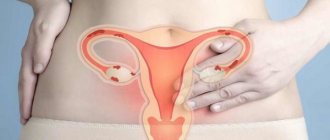The importance of progesterone for the female body: main functions and normal levels in the blood
The main physiological function of this hormone is to ensure the possibility of fertilization and the normal course of pregnancy. The female sex hormone is involved in preparing the endometrium for implantation of a fertilized egg, and also helps the uterine mucosa transform into the state necessary for the normal development of the embryo. Reduced progesterone levels increase the risk of premature birth.
Additional functions:
- stimulates the development of mammary glands;
- reduces pain during menstruation;
- prevents the appearance of polycystic ovary syndrome, mastopathy and other fibrocystic formations;
- regulates fat reserves in the body.
Special hormonal studies can determine the concentration of progesterone in the blood.
Norm of progesterone in women
Indicators depend on the phase of the menstrual cycle, trimester of pregnancy or use of hormonal contraceptives.
| Phase of the menstrual cycle/trimester of pregnancy | Unit of measurement: ng/ml (nanograms per milliliter of blood) |
| Follicular | 0,2-1,5 |
| Ovulatory | 0,8-3,0 |
| Luteal | 1,7-27,0 |
| Postmenopause | 0,1-0,8 |
| 1st trimester | 11,2-90,0 |
| 2nd trimester | 25,6-89,5 |
| 3rd trimester | 48,3-422,55 |
Hormonal fluctuations disrupt the functioning of the reproductive system, worsen appearance, and can also cause the development of pathologies of the female genital organs and mammary glands (uterine fibroids, mastopathy, endometriosis).
How to increase progesterone levels
There are a large number of drugs that can increase progesterone or stimulate its production, but the introduction of drugs can have ambiguous effects on a woman's body - from weight gain to termination of pregnancy. Progesterone is contained in tablets called:
Utrozhestan.- Duphaston.
- Norkolut.
- Orgametril.
- Exluton.
- Veraplex.
- Provera.
- Byzanne.
- Non-mestran.
All these drugs have a number of side effects and contraindications, so you should consult your doctor before using them.
Additionally, there are different types of topical gels or creams that can be applied to the arms or under the leg, in areas of the body where the skin is thinner.
In some cases, progesterone can also be given by injection. The doctor determines which injections are necessary based on the patient’s specific situation. Pharmacological products usually recommended at the initial stage are:
- vitamin C;
- vitamin E;
- vitamin B-6;
- beta carotene.
All of these elements can be found in a variety of foods, but higher amounts are required if the goal is to quickly increase progesterone levels.
How to compensate for the lack of progesterone naturally
Many pregnant women, in order to support their body during this period, want to learn how to increase progesterone naturally during pregnancy without resorting to medications. Moreover, they need to have the knowledge of how to increase progesterone levels naturally without synthetic hormones and drugs that can lead to unwanted side effects on the child's health.
The first thing you need to do is reduce stress. This is easier said than done for most women during pregnancy, but reducing stress can really work wonders. When the body suffers from stress, progesterone is converted into cortisol, which deprives the pregnant woman of an important hormone. Research has shown that the adrenal glands receive a signal to stop producing cortisol when a person thinks about something positive.
Reducing stress is one of the best stimuli for hormone production and the natural balance between them. Therefore, it is very important to know how to find moments for yourself in which you can relax your body and mind, allowing the body to regenerate.
The next step is to increase your diet's vitamin E intake. Studies have shown that 67% of women who took vitamin E on a daily basis were able to improve their hormonal balance. Some of the foods that contain vitamin E are:
- almond;
- raw seeds;
- chard;
- cabbage;
- spinach;
- avocado.
Some vegetable oils, including cottonseed and olive oils, are good sources of vitamin E.
And we also need to pay more attention to vitamin C. Which, as you know, is necessary for our immune system. Fertility studies have shown better hormone levels in women who regularly take vitamin C. Best sources of vitamin C:
- yellow pepper,
- guava,
- dark green leafy vegetables such as cabbage
- kiwi,
- broccoli
- strawberry.
Additionally, there are several essential oils that promote healthier hormone levels. These are sage oil, thyme oil, sandalwood oil, rose oil, lavender oil. However, you need to be careful when choosing oils, as some of them contain undesirable substances. A good rule of thumb is to read the instructions on the package.
Diet plays an important role in increasing the levels of this hormone. Beef, chicken and eggs, especially the yolk, in the diet on a regular basis can help in this matter. Dairy products also have high levels of progesterone. Products containing progesterone:
- red pepper (bell pepper);
- raw walnuts;
- raspberries;
- avocado;
- olives.
Ideal hormone balance can be achieved by eating walnuts, fortified cereals and whole grains, which are also rich in vitamin B6. Foods containing zinc, such as red meat, turkey and shellfish, should also be included in the diet.
According to research, there are certain culinary herbs that help increase hormone levels. These herbs—turmeric, thyme, and oregano—stimulate the body to produce more of this hormone and keep it in balance.
On the other hand, in order to increase progesterone, some recommendations must be followed. The first is to try to maintain a normal body weight. Therefore, it is necessary to avoid snacks during the day, fatty foods, heavy meals, and carbohydrates.
To increase the level of this hormone, it is recommended to consume dairy products. A noticeable increase is observed in those who consume dairy products at least three times a day (milk for breakfast, cheese for lunch and dinner).
The body can be forced to produce progesterone by consuming animal proteins - meat, fish and poultry. In addition, this hormone is well produced by simultaneous consumption of small amounts of fatty meat and eggs.
Cigarettes and alcohol are not permitted. Smoking is one of the main enemies in the production of progesterone in the ovaries.
Folk remedies
As mentioned above, progesterone can be raised with both medications and folk remedies. The following recipes will tell you how to increase progesterone in women using folk remedies:
Two tablespoons of dried raspberry leaves should be poured with two glasses of boiling water. Leave for an hour and drink in small portions throughout the day.
Mix wild yam and dried raspberry leaves. One tablespoon of the resulting mixture should be placed in a glass of boiling water and infused for several hours. Drink a tablespoon three times a day.
Progesterone-like phytohormones are found in yarrow root, which can be brewed as tea.
You cannot use mint, clover, or licorice root, as they have the opposite effect.
Reasons for decreased progesterone levels
- Unbalanced diet (lack of sufficient vitamins, micro- and macroelements)
- Constant stress, negative emotions, mental disorder
- Overwork (chronic fatigue syndrome)
- Smoking, alcohol abuse, drug addiction
- Poor environmental condition
- Taking medications (antibiotics, contraceptives)
- Hereditary diseases
- Pathology of pregnancy (placental insufficiency, impaired blood flow, unexplained fetal abnormalities)
- Uterine bleeding caused by hormonal imbalance
- Infectious diseases of the genital organs or oncology
- Kidney failure
- Ovarian dysfunction
- Thyroid dysfunction
How to normalize hormone levels with diet
You can normalize hormonal levels by eating appropriate foods. However, you need to remember that they do not contain progesterone. They help the body produce it.
These food ingredients include:
- dairy products;
- seeds;
- hard cheeses;
- eggs (yolks);
- legumes and nuts;
- dark chocolate;
- berry crops – raspberries, avocados;
- whole grain cereals;
- flax seeds;
- low-fat turkey, chicken.
Cholesterol is very important in the formation of progesterone. Therefore, butter, fish and meat should be included in the menu in reasonable quantities.
Food products must necessarily contain the following elements:
- magnesium - affects the pituitary gland, which regulates the rate of other hormones. Contained in chocolate and buckwheat. 320 mg per day is enough;
- Vitamin C – facilitates ovulation. The daily norm is 250–500 mg. Citrus fruits and cabbage are rich in it. It is better to eat raw, as heating destroys the vitamin;
- zinc – found in beef liver, seeds, sesame and lentils.
Vitamins B and P are a must. They are found in sufficient quantities in currants and rose hips.
This is interesting: Necessary tests and examinations for an abortion
Symptoms of low progesterone levels in women
Progesterone deficiency is a common cause of infertility and early pregnancy loss.
Signs of hormonal imbalance:
- Acne, age spots, hair loss
- Hyperfunction of the sebaceous glands
- Excessive body hair growth
- Frequent headaches
- Decreased sex drive
- Irregular menstrual cycle
- Vaginal dryness
- Swelling of the face or limbs
- Soreness in the area of the milk lobes and breast nipples
- Sudden weight gain (especially in the abdominal area)
- Irritability, emotional instability
- Exchange-endocrine disorders
There are several ways to increase progesterone in women: hormonal drugs, folk remedies and naturally (adjusting the diet). We will find out which foods contain progesterone and which medications restore the natural production of the female sex hormone.
Foods that increase progesterone levels.
This hormone is not found in any food. But research shows that certain foods can increase the amount by stimulating production in the body.
Magnesium.
In terms of content in the body, magnesium ranks fourth among all minerals, but almost 70% of the population is deficient. Not only does magnesium help the body absorb calcium, it also has a regulating effect on the main hormonal gland - the pituitary gland, which in turn regulates the levels of all hormones.
The pituitary gland produces follicle-stimulating hormone FSH, luteinizing hormone LH and thyroid-stimulating hormone TSH, on which the production of estrogen and progesterone depends. With magnesium deficiency, the pituitary gland produces less of the necessary hormones that keep the reproductive system in good shape.
How much magnesium do you need?
Recommended intake: 320 mg per day, but during pregnancy the requirement increases to 450 mg per day.
Foods high in magnesium.
- Dark green leafy vegetables. 100 g of spinach contains 79 mg.
- Nuts and seeds. 100 g of pumpkin seeds contain 534 mg.
- Buckwheat, 100 g 250 mg.
- Fish. 100 g of mackerel contains 97 mg.
- Whole grains. 100 g of brown rice contains 44 mg.
- Dark chocolate. 100 g of dark chocolate contains 327 mg.
Vitamin C (ascorbic acid).
Research shows that women who start getting adequate amounts of vitamin C increase their progesterone levels by 50-75%. Scientists believe that the ovaries need ascorbic acid immediately before ovulation, which it facilitates.
How much vitamin C should you get?
- Minimum: 85 mg per day.
- Recommended for increasing progesterone: 250-500 mg per day.
- Limitation: Do not take more than 1000 mg per day, since high doses of vitamin C acidify the body. In this case, the cervical fluid becomes acidic, suppresses sperm activity and prevents a woman from becoming pregnant.
Foods high in vitamin C (mg per 100 g).
Even more interesting:
What is Unidox prescribed for?
Ulcers due to thrush in women
- Currants, sea buckthorn - 200.
- Leafy greens - 120-170.
- Bell pepper – 128.
- Broccoli - 90.
- Persimmon – 66.
- Kiwi - 64.
- Oranges, lemons - 60-70.
- White cabbage - 50.
Remember that it breaks down quickly when boiled. For example, research shows that when broccoli is boiled for 5 minutes, it loses 36-55% of ascorbic acid. Therefore, it is important to eat fruits and vegetables high in vitamin C raw.
Vitamin B6.
Another vitamin that has definitely been proven to increase progesterone levels in women naturally. Getting enough of it is vital for normal hormonal levels.
Studies have shown that taking high doses of vitamin B6 reduces estrogen levels and increases progesterone levels and leads to improved symptoms of premenstrual syndrome (PMS). Women with high consumption reduce the chance of miscarriage by 50% and increase the chance of getting pregnant by 120%.
Norms, reasons for lowering the level
The level of progesterone contained in the female body depends on the phase of the cycle: in the first concentration is 1-4.7 nmol/l, during ovulation - from 2.4 to 9.5 nmol/l, and after the release of a mature egg and before menstruation, peak levels are reached values – from 16 to 86 nmol/l.
After conception has occurred, additional progesterone is produced by the corpus luteum formed at the site of the ruptured follicle - a temporary secretory gland. And progesterone concentrations during gestation in the 1st trimester can reach 10-100 nmol/l, in the second and third trimesters - up to 500.
The amount of progesterone may decrease for the following reasons:
- hormonal imbalances;
- menopause, menopause;
- gynecological diseases;
- genitourinary system infections;
- addictions: smoking and drinking alcohol in large quantities;
- neoplasms localized in the genitals or mammary glands (fibroids, tumors, cysts);
- unfavorable environmental conditions;
- severe stress;
- constant overwork and excessively intense loads, lack of sleep;
- unbalanced diet;
- long-term antibiotic therapy;
- long-term use of oral contraceptives;
- ovarian dysfunction;
- thyroid diseases;
- kidney diseases.
Good to know! It is possible to identify a decrease in progesterone levels independently by such symptoms as hair loss, deterioration of the skin (acne, increased fat content), body hair growth, weakened libido, menstrual irregularities, headaches, vaginal dryness, problems with conception, discomfort or pain in the vagina. mammary glands, mood swings, causeless changes in body weight (gain). During early pregnancy, spotting may appear as a sign of a threatened miscarriage.
Principles of proper nutrition to increase hormone levels
How can you increase progesterone? Adjust your diet and include the following foods in your diet:
- Fats, mainly vegetable, obtained from natural oils. It is adipose tissue that contributes to the production of female hormones, including progesterone. Therefore, during strict diets, the level of the hormone can drop sharply. You need to add olive oil, flax seed, and sunflower oil to your food. Animal fats are consumed in moderation.
- All kinds of nuts also contribute to the natural synthesis of progesterone: pistachios, cashews, hazelnuts, walnuts and pine nuts. They contain vegetable fats and healthy amino acids, as well as vitamins B and E that every woman needs.
- Foods high in ascorbic acid: Vitamin C strengthens blood vessels, ensuring normal blood supply to the genitals. Eat sauerkraut, citrus fruits, green onions, sour berries, bell peppers, leafy greens, kiwi.
- Green vegetables contain large amounts of B vitamins, as well as magnesium, which has a calming and relaxing effect. It is healthy to eat spinach and broccoli.
- A variety of beans rich in B vitamins and other nutrients are very useful: peas, lentils, beans, soybeans, peanuts (yes, they also belong to the legume category).
- Red sea fish of fatty varieties contains omega amino acids and vitamin E, which are necessary for stable hormonal levels. Eat salmon, salmon, trout, chum salmon. Also, be sure to eat the caviar of such fish.
- Seafood (shrimp, mussels, oysters, squid, scallops) contains phosphorus, calcium, vitamin D, and polyunsaturated fatty acids.
- Cereals and whole grain products based on buckwheat, millet, quinoa.
- As a snack, it is very useful for women to eat dried fruits rich in carbohydrates, magnesium and various vitamins.
- Be sure to include seaweed in your diet.
- Eat sesame seeds, flax seeds, and pumpkin seeds. They contain zinc and vitamin E, which normalize hormonal levels.
Medicines
It is not always possible to quickly normalize hormonal levels with proper nutrition alone. And if the decrease in progesterone is significant, the gynecologist, after studying the results of blood tests for hormones, may prescribe hormonal medications.
For progesterone deficiency, products based on natural progesterone (Utrozhestan, Crinon) or synthetic (Duphaston) are recommended. Such medications can be available in the form of tablets, vaginal suppositories and injection solutions.











